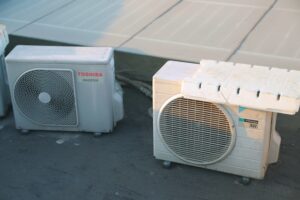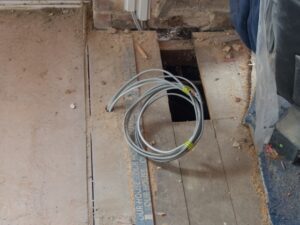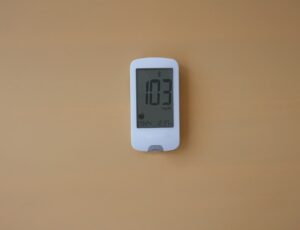Have you ever turned on the tap, expecting a steady flow of water, only to be greeted by a weak trickle?
Or maybe you’ve experienced the opposite—water coming out so forcefully that it splashes everywhere, causing frustration and potential damage. The culprit behind these issues might be your well pressure tank, and getting the psi just right is key to keeping everything running smoothly.
The ideal psi for most well pressure tanks typically falls between 40 and 60 psi. This range strikes a perfect balance, ensuring you have enough pressure for all the everyday tasks that require water—whether it’s taking a shower, washing dishes, or watering your garden.
But why is this PSI range so important?
If the pressure is too low, you could experience weak water flow, making it hard to complete daily tasks. On the other hand, if the pressure is too high, it may cause strain on your pipes and appliances, leading to leaks, bursts, and costly repairs down the line.
Getting the psi right means smooth water flow and fewer headaches in the future.
If you’re unsure whether your tank is set to the right pressure, don’t worry—we’re here to help.
Excel Mechanical specializes in setting and maintaining the perfect pressure for your well pressure tank. Our team is committed to providing high-quality HVAC and plumbing services tailored to your needs and budget.
In this blog, we will discuss:
- Why proper PSI is crucial for your water system’s performance.
- How to determine if your well pressure tank needs adjustment.
- What you can do to optimize your water system’s efficiency.
Let’s find out!
Understanding Well Pressure Tanks
So, what exactly is a well pressure tank, and why is it so important for your water system?
Let’s dive in!
Think of your well pressure tank as the backbone of your water system—it’s responsible for keeping water flowing smoothly throughout your home.
Without it, you’d be at the mercy of your well pump constantly turning on and off, which could wear it out much faster.
Purpose of a Pressure Tank
A well pressure tank is crucial for maintaining water pressure in your home.
It acts as a storage unit that holds water drawn from the well.
When you turn on a faucet, water first comes from the tank, reducing the need for the pump to start immediately. This allows for a more consistent water supply and extends the life of your pump.
By using a pressure tank, you can minimize the on-off cycling of the pump, which is vital for energy efficiency.
Components of a Pressure System
So, what’s inside the system that makes it all work?
Well, there are a few components that play a role:
- The Pressure Tank: As we mentioned, this is the heart of your system. It stores the water and maintains pressure.
- The Pressure Switch: This little device is responsible for monitoring the pressure in your system. When it drops too low, it turns the pump on to refill the tank.
- Check Valves and Piping: These ensure the water flows in the right direction and prevent backflow, keeping everything nice and safe.
When all these components work together, you get consistent water flow without the constant switching of the pump, which is more energy-efficient and saves wear on your system.
Determining Proper Pressure Settings
Now that we know what a well pressure tank is and why it’s so important, let’s talk about the pressure settings. If you’ve ever noticed water pressure issues, you know how frustrating it can be.
Too much pressure and your pipes may burst; too little pressure, and you’re left with weak showers and trickling faucets. Finding that sweet spot is key!
So, how do you determine the correct pressure settings for your well system?
Let’s break it down.
Calculating Cut-In and Cut-Out Pressure
To understand pressure settings, let’s first define cut-in and cut-out pressure.
- Cut-in Pressure is the point where the pump kicks on. This is typically set between 30 to 40 psi. When the water pressure in your tank drops below this level, the pump activates to refill the tank.
- Cut-out Pressure is the point where the pump turns off, usually set between 50 to 60 psi. Once the pressure hits this range, the pump shuts off, and the pressure is maintained in the tank.
It’s crucial to keep these settings in the right range because:
- If the cut-in pressure is too high, your pump could turn on more frequently, causing wear and tear.
- If the cut-out pressure is too high, it could lead to over-pressurizing your system, potentially causing leaks and other damage.
If you’re not sure where your settings are, you can always check the manual or the manufacturer’s label. But don’t worry, Excel Mechanical can help you assess and adjust your well system pressure with ease, ensuring everything’s set just right for optimal performance.
Pressure Tank Ratings
Another factor to keep in mind is the pressure tank rating. This rating tells you the maximum pressure the tank can safely handle.
Common ratings are 100 psi, 125 psi, and 150 psi.
The key here is making sure that the tank rating matches the pressure requirements of your system. If you use a tank that’s rated for a lower pressure than your system requires, you’re opening yourself up to potential issues like leaks or damage.
Setting the Correct PSI
Having the right pressure settings is key to ensuring your well pressure tank works efficiently, but how do you go about setting it?
Well, don’t worry, it’s not as complicated as it sounds!
With just a few steps, you’ll have everything in check.
Adjusting Air Pressure in the Tank
To adjust the air pressure, start by turning off the power to the well pump. This prevents the pump from cycling while you work. Then, drain the tank completely using a nearby faucet.
Once the tank is empty, use an air compressor to adjust the air pressure.
The recommended pressure setting should be 2 PSI lower than the cut-in pressure of your pump. For example, if the pump’s cut-in pressure is 30 PSI, set the tank to 28 PSI.
This ensures smooth operation and helps avoid over-cycling, which can wear out the pump and tank.
Checking Tank Pressure with a Gauge
Using a pressure gauge is essential for verifying the correct PSI setting.
Attach the gauge to the tank’s air valve. Then, ensure the gauge reads the empty tank pressure, as water pressure should not affect this reading.
Check that the gauge reading matches the desired pre-charge setting before turning the pump back on. If the readings vary, recalibrate the tank’s air pressure.
Regular checks with a gauge help maintain accurate pressure and identify any discrepancies early, preventing potential issues with your water system.
Regular Maintenance and Monitoring
When it comes to your well pressure tank, the old saying “an ounce of prevention is worth a pound of cure” couldn’t be more true.
Regular maintenance doesn’t just keep your system running smoothly, but it also prevents small problems from turning into expensive repairs.
Inspection Intervals
Perform inspections every six months to check the tank’s condition.
Examine the exterior for rust or leaks and ensure all connections are secure. Test the pressure gauge to confirm it’s within the recommended range. During inspections, listen for unusual sounds that might indicate a problem with the bladder or diaphragm inside the tank.
You should ensure that the air charge is accurately maintained by comparing it to specified levels. Performing these checks regularly helps in detecting minor issues before they become significant, avoiding disruptions in your water supply.
Troubleshooting Common Issues
You might be wondering, “What should I do if I notice something wrong during an inspection?” Here’s where the real savings happen—early detection!
Let’s break down some common issues and how you can troubleshoot them.
- Low Water Pressure: If you’re dealing with low water pressure, first check the pressure setting on your tank. If it’s too low, you may need to adjust it according to the manufacturer’s recommendations. Another cause could be a waterlogged tank, which happens when the bladder inside the tank gets compromised. If this is the case, you’ll need to address it quickly.
- Unusual Noises: If you hear banging or gurgling, that’s often caused by air leaks. Check around the tank for any cracks or faulty connections. These leaks can lead to pressure fluctuations and can affect your system’s efficiency. If you spot anything, it’s a good idea to consult a professional.
- Leaks Around the Tank: If you notice any leaks, that could be a sign that something’s wrong with the internal components. It’s important to address leaks right away, as they can lead to water damage in your home and a wasted supply of water.
Remember, even if these issues don’t seem like a big deal right now, catching them early prevents bigger headaches down the road.
Professional Installation and Adjustment
When it comes to your well pressure tank, proper installation and adjustment are non-negotiable for ensuring long-term performance and efficiency. You might think it’s just about setting it up and walking away, but a lot goes into ensuring everything is working at its best.
Hiring a Licensed Technician
Choosing the right professional for installation is crucial.
A licensed technician has the expertise to set up your well pressure tank properly, adhering to safety standards and ensuring peak efficiency. Look for someone certified, experienced, and familiar with various tank models.
Excel Mechanical stands out as a top choice for HVAC and plumbing services, offering exceptional quality and value. Our trained professionals will evaluate your specific needs, providing a tailored solution that fits your budget.
By hiring experts, you avoid costly future repairs and enjoy reliable performance.
Understanding Installation Standards
Installation standards ensure that your well pressure tank operates safely and efficiently.
Key aspects include verifying the correct PSI setting, securing proper connections, and inspecting for leaks.
Technicians follow guidelines to maintain water quality and pressure stability. Knowing these standards helps you understand the importance of professional installation. Our technicians not only meet these standards but strive to exceed them, ensuring a flawless setup for your plumbing needs.
Properly installed systems by experts result in fewer maintenance issues, saving you time and money in the long run.
Safety Considerations
Let’s talk safety.
A well pressure tank can be a significant part of your plumbing system, and while it’s important to maintain pressure, you also need to keep things safe.
Pressure Relief Valves
Pressure relief valves are essential components of a well pressure tank system. They automatically release excess pressure if it rises too high, preventing potential damage or failure.
Properly installed and maintained, these valves are crucial for safety.
Regular inspections of the pressure relief valve are necessary. Check for any signs of corrosion or blockage. If the valve does not open when it should, it might need cleaning or replacement. Always follow the manufacturer’s guidelines when testing or servicing these valves.
In areas with frequent pressure fluctuations, a reliable pressure relief valve is vital.
Avoiding Tank Over-Pressurization
Preventing over-pressurization in your well pressure tank is critical for safety.
Over-pressurization can lead to tank bursts, resulting in water damage and posing safety risks. To avoid this, regularly monitor the tank’s pressure levels.
Use a pressure gauge to keep an eye on the system. Ensure it stays within the recommended PSI range. If you notice unusually high readings, it might indicate a malfunction needing immediate attention.
Routine maintenance and inspections by professionals help prevent these issues. Hiring experienced service providers ensures that you receive the best advice and service.
Environmental and Energy Efficiency Concerns
Are you conscious of your energy consumption and environmental footprint?
Well pressure tanks can have a significant impact on both. A well-maintained tank and proper installation can drastically reduce your energy bills and improve overall system efficiency.
Reducing Energy Usage
To reduce energy usage, ensure that your well pressure tank is properly maintained.
Regular inspections help avoid leaks, which can lead to unnecessary pump usage.
Installing a variable speed pump can also save energy by adjusting motor power based on water demand.
Use a tank with the right capacity for your needs. An oversized tank can waste energy, while an undersized one may cause frequent cycling of the pump, increasing energy costs. Effective insulation around the tank can further reduce energy loss.
Simple habits like fixing leaks promptly and only running water when necessary significantly cut back on energy consumption. These practices ensure your system operates efficiently, lowering your energy bill and extending the life of your equipment.
Eco-Friendly Practices
Adopting eco-friendly practices not only benefits the planet but can also lead to long-term savings. Choose a tank made from sustainable materials to minimize environmental impact. Recycling old tanks responsibly prevents harmful waste.
Regular maintenance is KEY. By ensuring your system works correctly and efficiently, you reduce the likelihood of sudden breakdowns that require extensive repairs and resources. This proactive approach minimizes waste.
Working with a company like Excel Mechanical ensures you receive top-quality service and sustainable solutions. Our team’s dedication to exceptional quality and great value makes us the best choice for both residential and commercial HVAC and plumbing needs, tailored to individual preferences and budgets.
Frequently Asked Questions
When it comes to maintaining your well pressure tank and ensuring its longevity, there are always a few common questions that come up. We’ve compiled answers to some of the most frequently asked questions to help you better understand your system and keep everything running smoothly.
How much air pressure is ideal for a well pressure tank?
The ideal air pressure in a well pressure tank is typically 2 psi below the pump cut-in pressure. For example, if your system’s cut-in pressure is set at 30 psi, the tank should be at 28 psi. This ensures that the water pressure remains steady.
What are the steps to properly set a pressure tank’s psi for optimal performance?
Setting the pressure correctly is key to maintaining a steady water flow. Here’s what you’ll need to do:
- Turn off the power to the pump to prevent it from cycling while you adjust the settings.
- Drain the tank completely to ensure you get an accurate reading of the air pressure.
- Use a pressure gauge to check the existing air pressure.
- Adjust the pressure with an air compressor or hand pump to get it to the ideal psi setting.
- Turn the power back on, and ensure everything is working properly.
Is it possible to adjust the air pressure in a pressure tank that contains water?
Adjusting the air pressure while the tank contains water is discouraged. For accurate adjustments, the tank should be drained completely. This ensures that air pressure readings are not affected by the water pressure inside the tank.
What indications signal that a bladder tank pressure may be excessively high?
If you notice any of the following signs, your bladder tank pressure may be too high:
- Rapid cycling of the pump, where it turns on and off frequently.
- Unusual noises coming from the tank or pipes, which could be caused by excessive pressure.
- Reduced water flow or inconsistent water pressure.
If you encounter these symptoms, it’s time to check your pressure and adjust it if needed. If the problem persists, consult a professional to avoid damage to your system.
What should the water pressure range be for a residential well system?
Water pressure for a residential well system typically ranges from 40 to 60 psi. Maintaining this range helps ensure a steady water supply without causing unnecessary strain on the plumbing system.
How do you choose between a 30/50 and a 40/60 pressure switch for a well?
Choosing between a 30/50 or 40/60 pressure switch depends on the water pressure needs of your household. A 30/50 switch is suitable for homes with moderate water use, while a 40/60 switch offers higher pressure for larger homes or those with higher water demands.
Excel Mechanical can ensure your system is set up for optimal performance. We focus on quality and value, providing tailored solutions to meet your specific needs and budget. Our expertise in HVAC and plumbing makes us the top choice for residential and commercial services.




